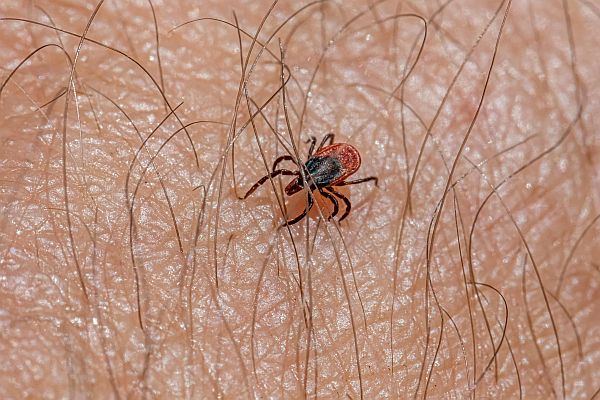Last Updated on August 1, 2025 by Bertrand Clarke
As summer unfolds across the United States, a tiny but formidable threat is making headlines: ticks. These small arachnids, notorious for spreading diseases like Lyme disease and Rocky Mountain spotted fever, are seeing a significant uptick in activity in 2025. According to the Centers for Disease Control and Prevention (CDC), emergency room visits for tick bites this year have reached their highest levels since 2019, with the Northeast reporting 229 visits per 100,000 ER cases in June alone—a sharp rise from 167 per 100,000 the previous year. Experts point to a combination of climate change, habitat expansion, and human behavior as the driving forces behind this alarming trend. But fear not—there are practical steps you can take to stay safe while enjoying the great outdoors.
A Perfect Storm for Ticks
The surge in tick bites is no coincidence. Climate change is reshaping the environment in ways that favor these blood-sucking pests. Warmer winters and wetter springs are extending tick breeding seasons, allowing populations to thrive and expand into new regions. “We’re seeing ticks move into geographic areas where they haven’t been prevalent before,” says Dr. Maria Bente, an infectious disease specialist, speaking on CBS Mornings. “Milder winters mean ticks are active for longer, and wetter conditions create ideal breeding grounds.”
The data backs this up. A 2025 report from Binghamton University highlights how rising temperatures are enabling ticks to survive in regions previously too cold for them. Deer ticks, also known as blacklegged ticks, which are primary carriers of Lyme disease, are now found as far north as Canada, moving at a rate of over 20 miles per year, according to Catherine Bouchard, a research scientist at the Public Health Agency of Canada. Meanwhile, the lone star tick, infamous for triggering a red meat allergy, is pushing northward from its traditional southern strongholds, with sightings as far as Canada.
Human activity is also playing a role. Suburban sprawl has brought people closer to tick habitats, as new housing developments encroach on forested areas. “Suburbanization has increased human-tick encounters,” explains Durland Fish, PhD, professor emeritus at Yale School of Public Health. “As we move into these areas and restrict deer hunting for safety, deer populations—the primary hosts for deer ticks—are booming.” Fish notes that the deer tick’s range has expanded to 16 northern states over the past 50 years, largely due to the reintroduction of white-tailed deer into regenerated forests.
The Health Risks of Tick Bites
Ticks are more than just a nuisance—they’re a public health concern. The CDC estimates that nearly 31 million Americans are bitten by ticks annually, and while most bites are harmless, some can transmit serious illnesses. Lyme disease, caused by the Borrelia bacteria, remains the most common tick-borne infection in the U.S., with approximately 476,000 cases diagnosed each year. Symptoms can range from fever and fatigue to joint pain and, if untreated, severe neurological issues.
Other tick-borne diseases are also on the rise. In the Southeast, Rocky Mountain spotted fever, carried by the American dog tick, is a growing concern, with symptoms including high fever and a distinctive rash. The lone star tick, prevalent in the South but increasingly found in northern states, can cause ehrlichiosis, a flu-like illness, and even a rare allergy to red meat known as alpha-gal syndrome. In the Northeast, ticks like the deer tick can transmit babesiosis and anaplasmosis, which can lead to severe complications, particularly in older adults and those with compromised immune systems.
Dr. Andrew Handel, a pediatric infectious disease specialist at Stony Brook Children’s Hospital, emphasizes the regional variation in tick risks. “In the Northeast, we’re seeing a lot of deer ticks and lone star ticks, each carrying different pathogens,” he told PBS News Weekend. “The key is to know what ticks are in your area and what diseases they might carry.”
Why 2025 Is a Banner Year for Ticks
This year’s tick season is proving particularly intense. In the Northeast, states like Maine, Massachusetts, and Rhode Island are reporting “above average” numbers of American dog ticks, according to Sam Telford, an infectious disease expert at Tufts University. New York has seen a higher number of reported deer tick bites compared to 2024, says Saravanan Thangamani of SUNY Upstate Medical University. The CDC’s data underscores this trend, noting a spike in tick-related emergency room visits, particularly in June and July.
Climate isn’t the only factor. The longhorned tick, an invasive species from Asia, is gaining a foothold in the U.S., particularly on the East Coast. Unlike other ticks, female longhorned ticks can reproduce without mating, laying up to 2,000 eggs at a time. “This ability to clone themselves makes them particularly difficult to control,” says Laura Goodman, an assistant professor at Cornell University. The longhorned tick has been spotted as far west as Ohio, raising concerns about its potential to spread diseases like bovine theileriosis to livestock and, potentially, humans.
Protecting Yourself and Your Family
While the rise in tick activity is concerning, experts stress that there are effective ways to minimize your risk. Prevention starts with awareness and preparation, especially during outdoor activities like hiking, gardening, or camping. Here are some practical steps to keep ticks at bay:
- Dress Smart: Wear long sleeves, long pants, and closed-toe shoes when venturing into wooded or grassy areas. Tuck your shirt into your pants and your pants into your socks or boots to create a barrier. Light-colored clothing makes it easier to spot ticks.
- Use Repellents: Apply EPA-registered insect repellents containing DEET, picaridin, or oil of lemon eucalyptus to exposed skin. For clothing, treat gear with permethrin, a chemical that repels and kills ticks on contact. “Permethrin-treated clothing is a game-changer,” says Negar Elmieh of Canada’s National Collaborating Center for Environmental Health.
- Stay on Trails: When hiking, stick to the center of well-maintained trails to avoid brushing against shrubs and tall grasses where ticks often lurk.
- Check Thoroughly: After spending time outdoors, perform a full-body tick check on yourself, your children, and your pets. Focus on warm, moist areas like the armpits, groin, behind the knees, ears, and scalp. “Ticks love those hidden spots,” notes Elmieh.
- Shower and Wash: Shower within two hours of coming indoors to wash off unattached ticks. Toss clothes in a dryer on high heat for 10–15 minutes to kill any ticks that might be clinging to fabric.
If you find a tick attached to your skin, remove it promptly to reduce the risk of disease transmission. “Use fine-tipped tweezers to grasp the tick as close to the skin as possible and pull gently but firmly,” advises Amanda Roome of the Tick-borne Disease Center. Avoid jerking or twisting, as this can leave the tick’s mouthparts embedded. Most tick-borne diseases, including Lyme, require the tick to be attached for 24–36 hours to transmit pathogens, so quick removal is key.
What to Do If You’re Bitten
Not every tick bite leads to illness, but it’s wise to stay vigilant. Monitor the bite site for signs of infection, such as redness, swelling, or a bull’s-eye rash, which is a hallmark of Lyme disease. If you develop symptoms like fever, fatigue, joint pain, or a rash within days or weeks of a bite, contact a healthcare provider and inform them of the bite and your location. “Knowing where you were bitten helps doctors assess which diseases you might be at risk for,” says Thomas Hart, an infectious disease microbiologist at Johns Hopkins University.
The CDC advises against routine tick testing, as results can be unreliable. Instead, focus on symptom monitoring and prompt medical consultation if concerns arise. Resources like the University of Rhode Island’s TickEncounter and the CDC’s Tick Bite Bot can provide guidance on next steps.
Looking Ahead: A Growing Challenge
As tick populations continue to expand, experts warn that 2025 may be a harbinger of future challenges. Climate models predict that warming temperatures will further extend tick habitats, potentially increasing the incidence of tick-borne diseases. “This is a wake-up call,” says Dr. Shannon LaDeau, a disease ecologist at the Cary Institute of Ecosystem Studies. “We need to adapt our behaviors and public health strategies to this new reality.”
For now, individuals can take charge by staying informed and proactive. Whether you’re hiking in the Northeast, gardening in the Midwest, or exploring parks in the South, a little caution goes a long way. As Telford puts it, “Every season is tick season.” By arming yourself with knowledge and the right precautions, you can enjoy the outdoors while keeping these tiny invaders at bay.









